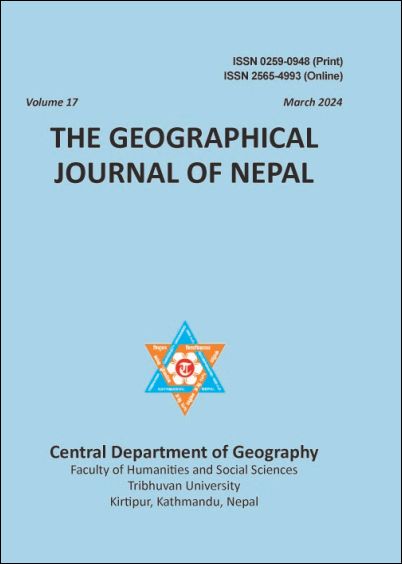Exploring place attachment: Insights from post-Gorkha earthquake resettlement planning in Nepal
DOI:
https://doi.org/10.3126/gjn.v17i01.63936Keywords:
place attachment, place dependence, residential satisfaction, integrated settlement, post-disaster resettlementAbstract
This study investigates the relationship between place attachment and resettlement planning in Nepal post the Gorkha Earthquake of 2015. Focusing on functional place dependence, it analyses place attachment within the Panipokhari Integrated Settlement, designed for the Thami community in Dolakha district. Using "residential satisfaction" as a parameter to measure the influencing factors of place dependence, data were collected through a Likert scale survey, interviews, and observations. The analysis encompassed Cronbach's Alpha for reliability (α = 0.825), mean satisfaction scores for evaluation, and Spearman’s rank correlation to explore relationships between residential satisfaction parameters and place dependence factors. The study revealed significant correlations, highlighting varied influences on place attachment. Notably, social connectivity, represented by nearness to relatives (r = 0.720, p = 0.000), exhibited a strong positive correlation. Similarly, infrastructure amenities like electricity (r = 0.532, p = 0.000) displayed a relatively strong positive correlation, while access to health facilities (r = 0.447, p = 0.002) demonstrated a moderate positive correlation. Moreover, settlement planning components—kitchen gardens (r = 0.623, p = 0.000), open spaces (r = 0.578, p = 0.000), settlement layout (r = 0.549, p = 0.000), and cattle sheds (r = 0.574, p = 0.000)—significantly correlated with increased attachment. Additionally, housing design factors like immediate exterior spaces (r = 0.730, p = 0.000), spaces for life cycle rituals (r = 0.771, p = 0.000), and social events (r = 0.663, p = 0.000) and building performance factor winter thermal comfort (r = 0.606, p = 0.000)displayed substantial positive correlations. Acknowledging study limitations, it offers insights for planners and policymakers, stressing holistic approaches for sustainable resettlement. Future research should explore diverse factors and contexts, emphasizing the dynamic nature of place dependence. Ultimately, the study underscores the intricate relationship between satisfaction parameters and place attachment, urging comprehensive resettlement strategies.
Downloads
Downloads
Published
How to Cite
Issue
Section
License

This work is licensed under a Creative Commons Attribution 4.0 International License.
© Authors




